- March 05, 2024
- By Karen Shih ’09
NADRA WASS ’99, ’00 REMEMBERS THE HECKLERS.
On a cool spring evening, she marched with more than a hundred female students across the University of Maryland during the annual “Take Back the Night” rally to end sexual and domestic violence. As they wound their way around McKeldin Mall and up toward North Hill, male students stuck their heads out of their dorm windows and hurled the worst insults they could think of: lesbians, f---ing d----s.
“It wasn’t a huge surprise,” says Wass, who is pansexual and had heard disparaging—if less crude—sentiments about queer people in her engineering classes. “I didn’t necessarily feel unsafe because we were a sizeable group, but anytime you’re out walking at night and someone is yelling, there is the feeling of, ‘What’s going to happen now?’”
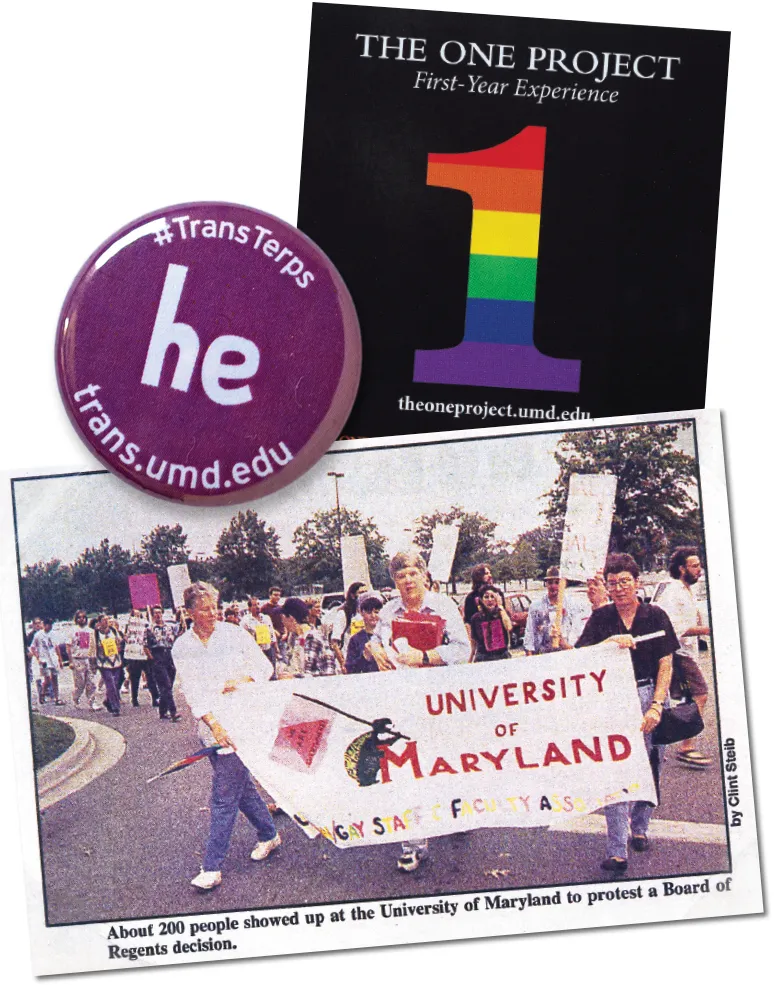
Rather than intimidate her, the experience fueled her desire to create a safer and more welcoming campus for fellow lesbian, gay, bisexual and transgender students at a time when “Don’t Ask, Don’t Tell” was the dominant ethos, Congress overwhelmingly passed the Defense of Marriage Act, and the tragedy and pain of the AIDS crisis lingered.
Wass joined forces with dozens of determined students, faculty and staff members to expose discrimination and fight for rights and resources for the queer community on campus, culminating in the establishment of a small LGBT resource office in the Computer and Space Sciences Building off Regents Drive.
Twenty-five years later, the LGBTQ+ Equity Center, now in a cozy, welcoming space just off McKeldin Mall, is at the heart of queer organizing and support at UMD. The center hosts events throughout the year like trivia night and Lavender Graduation; offers training and education for Terps seeking to become better allies; and advocates for inclusive health care, housing, bathrooms and more.
Those efforts have paid off: In fall 2023, UMD was named the top college in the nation for LGBTQ+ students by Campus Pride and BestColleges.
“We celebrate this accomplishment,” says new center Director Kristopher Oliveira, but “we are eager to continue enacting policies and practices where all Terrapins feel—and are—fully embraced.”
As the LGBTQ+ Equity Center celebrates its milestone anniversary, the faculty, staff and students who made it possible and helped shape its evolution tell its story.

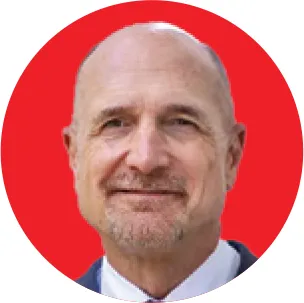
LUKE JENSEN
FOUNDING DIRECTOR OF THE LGBTQ+ EQUITY CENTER
I was hired at UMD as the associate director of the Center for Studies in Nineteenth-Century Music in 1988. But my partner had contracted AIDS, so we had to continue to travel back to New York, where we previously lived, for health care. He died in January of 1990. It was very, very hard. I saw colleagues getting all kinds of benefits for their partners and children. And I couldn’t provide that kind of support for the person I loved.
In the spring of 1991, I said to myself, “Luke, if you’re going to be here, you need to make ‘here’ better than what it is.” Then, a friend from a grief support group had told me about an ad in the Washington Blade (the gay and lesbian newspaper) for a faculty and staff group forming at UMD.
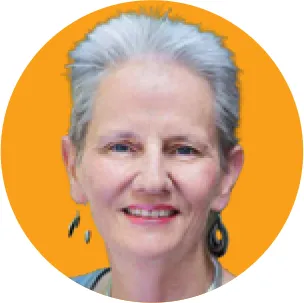
MARILEE LINDEMANN
PROFESSOR OF ENGLISH, EXECUTIVE DIRECTOR OF COLLEGE PARK SCHOLARS, DIRECTOR OF THE LGBT STUDIES PROGRAM (2002-14)
When I arrived in 1992, there was no official place on campus or entity on campus that advocated for LGBT people, to make them feel welcome, like they belonged and were supported. There was an invisibility from an institutional standpoint.
In the early days, I heard about people meeting in basement rooms and keeping it on the down-low. But not long after I arrived, we established a Lesbian and Gay Staff and Faculty Association. Our first major issue was domestic partner benefits.
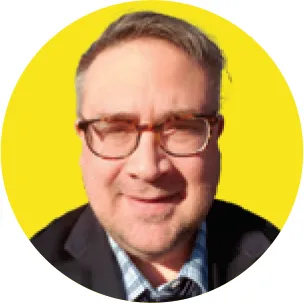
KEVIN FRIES ’96, M.L.S. ’05
One of the things that has stuck with me all my life was watching very respected, elderly, accomplished professors testify before the University Senate, really, in tears. They were saying, “Please treat us equally. We give our lives to our work. We love and live like everybody else. This is not right.”
LINDEMANN: It wasn’t fully resolved until gay marriage was made legal in Maryland (in 2013). We think of Maryland as a very blue state, so I was surprised by the resistance we encountered. I was in a position of great privilege as a tenured faculty member in a supportive department that hired both me and my partner (Martha Nell Smith). But others were harassed.
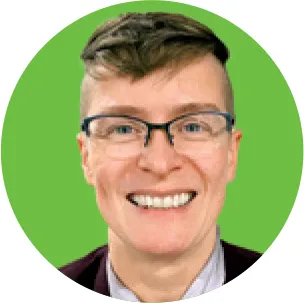
NADRA WASS ’99, ’00: In the engineering school, they would discuss domestic partnerships in front of me without knowing I was pansexual. They’d say things about how these relationships weren’t valid. That informed how safe I felt about telling them about my identity, even though I was out to other people on campus.
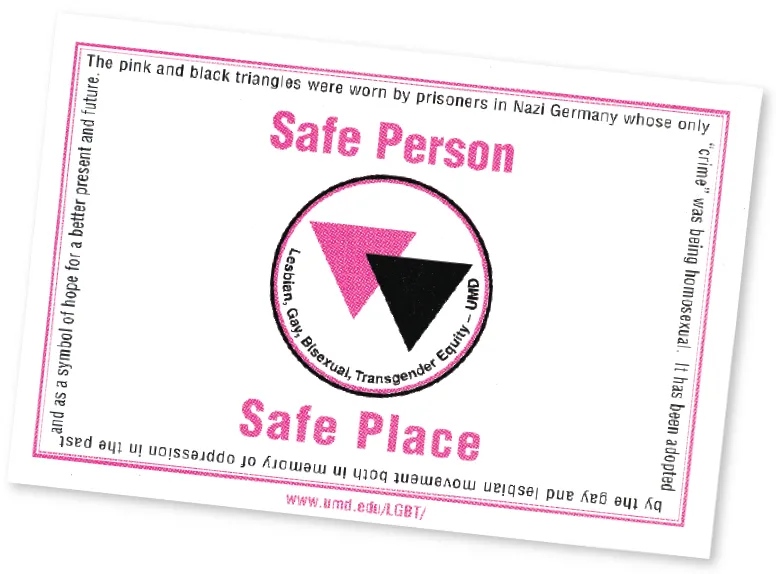
FRIES: I remember there were these “safe space” cards. Faculty and staff were supposed to put them on their desk or door so people could feel comfortable more quickly. That was important because one of the biggest challenges at the time was visibility—you didn’t know who was who and what was what. But I know some people who were supportive still didn’t want to hang something up that they thought would send the wrong message.
JENSEN: A group of us said “OK, we’re going to study how to gain domestic partner benefits and improve the situation for LGBT people on campus.” We worked very closely with students because they needed to have the courage to stand up for themselves. If they were being mistreated, they didn’t have to just take it.
Lindemann, Fries and Wass were also part of that group. Its 1996 “Embracing Diversity” report documented heartbreaking examples of harassment and erasure of LGBTQ+ students and employees, such as a female professor called “mentally unstable” for having a female partner, and the lack of institutional support, contrasting with what the report called UMD’s “vigorous response” to addressing discrimination against people of color or women.
JENSEN: We came up with three recommendations: 1. a presidential commission on LGBT issues, 2. the creation of a resource center and 3. the creation of a LGBT studies program.
Luckily, Provost Greg Geoffroy arrived in 1997, and he had come from Penn State, where they had a coordinator for LGBT equity in his office, so he supported creating one here. It started with just me overseeing a couple of undergrads in Fall 1998.
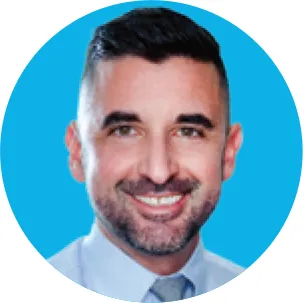
JOEY DESANTO JONES ’02
You couldn’t go to an LGBT event on campus and not see Luke Jensen. He’s quirky and intelligent and clearly so passionate. It was my introduction to university life. For me, the Office (of Lesbian, Gay, Bisexual and Transgender Equity) provided constant support and validation, because of that visibility.
JENSEN: One of the first things we did was start holding a welcome reception at the beginning of the year, now known as Quelcome. Hardly any LGBTQ students came out the first year. But we started a listserv, put information in first-year student packets and worked hard to get the word out. Now, it’s like a resource fair and a big party. Our goal was making connections: If you were an LGBTQ student in engineering, how would you meet one in English?
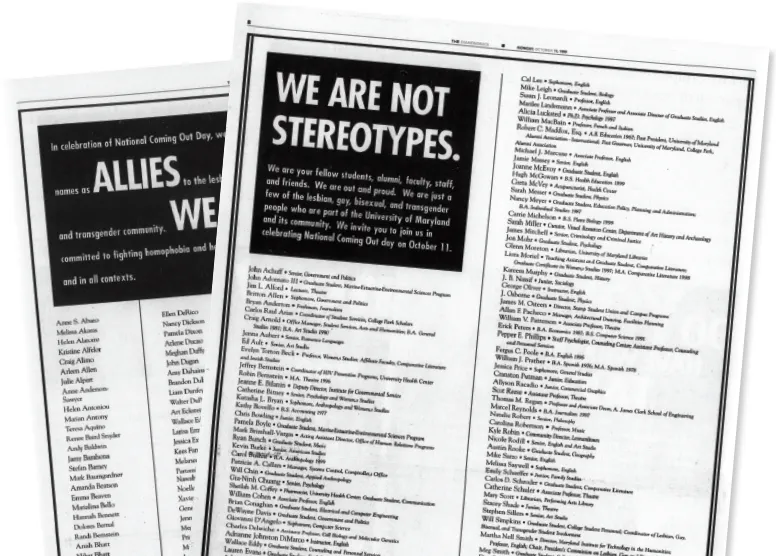
Part of that was publishing the “out” list in The Diamondback every year for National Coming Out Day. Initially (in 1993) it was almost all faculty and staff, then more students joined. I knew students who would keep it taped up in their dorm. There was some pushback. One year, a staff member—who had actively campaigned to have my job eliminated and the office closed—took the list and called and emailed everyone, telling them that being gay was wrong. It really frightened some of our kids.
LINDEMANN: My name was on it every year. I always felt a great responsibility to be as visible as I comfortably could be. I still mention that I’m gay in my opening speech for College Park Scholars each fall. It’s important for students to see people in positions of power who share something in common with them.
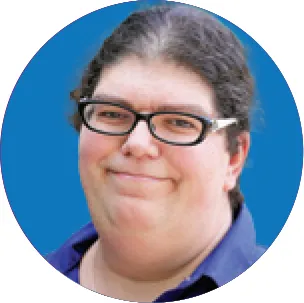
ADRIANA FALCO ’03
FORMER PRESIDENT OF THE PRIDE ALLIANCE
I would have felt really isolated in college without the Pride Alliance and the LGBT Office. My mother at first was not particularly supportive of my identity. But at Maryland, I made close friends. We went to the Millennium March, created a float for Homecoming—it all changed how I looked at the world and interacted with people.
In the 1970s, well before formal LGBTQ+ resources were offered at Maryland, gay and lesbian students created the Speakers Bureau, which sent queer students to classes to speak about their experiences. Jensen in the 1990s pushed for speakers, now known as peer educators, to get credit for their work. It’s now offered as LGBT350, “Lesbian, Gay, Bisexual, and Transgender People and Communication.”
FALCO: It was a great experience. We opened people’s eyes to the types of struggles that LGBTQ+ people had with mental health. That opened the door for a lot of people to talk to us, whether students were identifying that way or thinking about it.
JENSEN: Classes about lesbian and gay topics had existed since the 1970s, but nothing cohesive. When we submitted the request for an LGBT Studies Program to the Faculty Senate, we had some absolutely horrific and silly things said by senior faculty in a couple committees. One of them actually said, “What’s next, bestiality studies? Man on dog?”
LINDEMANN: Universities are seen as a hotbed of leftist radical activism, chasing trends and all that. But in trying to establish the program, we encountered resistance at every step.
JENSEN: When it came for the full Senate vote, this guy raised his hand again. Ruth Fassinger, a counseling psychology professor, put him in his place. Then nobody else had anything else to say. I started panicking, thinking that was a bad sign. But it passed almost unanimously. It was understood: We needed the program.
LINDEMANN: I was delighted that from the moment the program formally started in 2002, we had lots of allies sign up. That speaks well of Maryland’s students.
The same couldn’t be said of the tailgaters in Lot 1. The program used to be in Tawes, and the main restroom they’d use was down the hall from our office. On Mondays, we would find posters or our bulletin board defaced. We started coming in on game days and sitting outside the office. It felt important to me to put names and faces: This is who you are attacking when you’re writing crude and nasty things. I gave out bumper stickers that said “Real Terps Support LGBT Studies.”
JENSEN: A lot of people needed education, even allies. We developed the Rainbow Terrapin Network to train units like housing, finance and health. Because for students, if your parents cut you off and you needed financial aid, would you feel comfortable coming out to people in that office? We gave pins and a card to everyone who participated so they could visibly show their support.

That training helped open the eyes of faculty and staff across campus, including at the University Health Center.
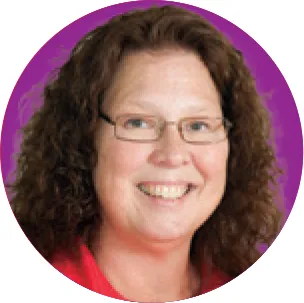
PENNY JACOBS
NURSE PRACTITIONER AT THE UNIVERSITY HEALTH CENTER
In 2009, a student coming from California contacted me because they needed gender-affirming care. I asked for and received permission to extend this person’s hormone prescriptions here at the University Health Center. I had never done that before—it wasn’t something they even covered in nurse practitioner or medical school.
As I monitored them, I started reading as much as I could get my hands on and went to conferences. We started initiating hormone care here in 2011, and now, 60-80 students are enrolled. We’ve been really on the forefront, sharing knowledge and experiences with universities across the country.
A decade later, the office had three full-time staff members and moved again, this time from the basement of Cole Field House to its current space in Marie Mount Hall, featuring a library full of LGBTQ+ books and space for student groups to meet.
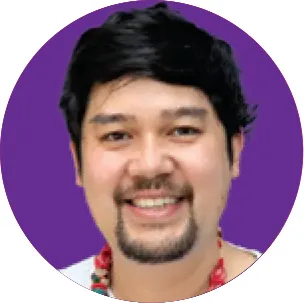
SHIGE SAKURAI
ACTING DIRECTOR, ASSOCIATE DIRECTOR AND DIRECTOR OF LEADERSHIP INITIATIVES FOR THE LGBTQ+ EQUITY CENTER (2010-22)
When I arrived, Luke focused on training and advocacy. I tried to bring more programming and helped change it from an “office” to “center,” so more people would see it as a place to go.
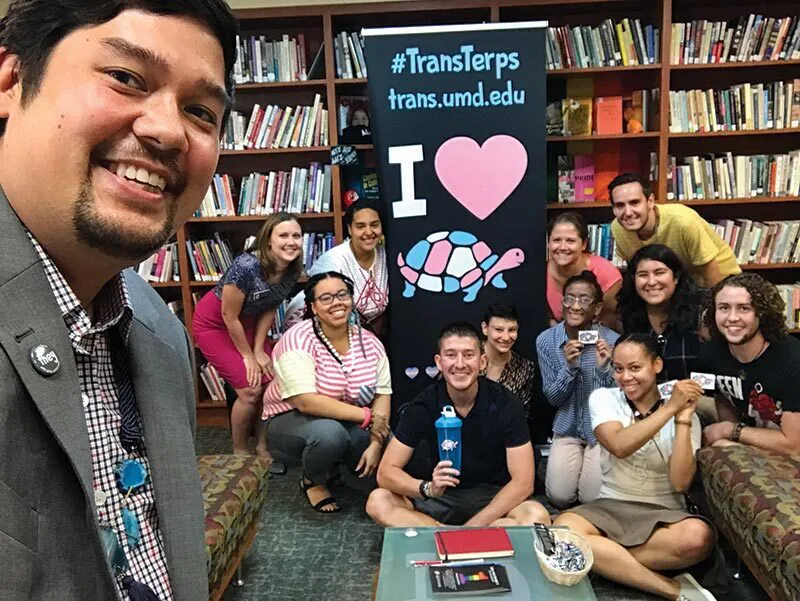
One thing I’m proud of is starting the Trans Terps Project, launched in 2017. There weren’t a lot of publications telling us what had been tried and tested, so we created an informal coalition to develop good practices. We talked to trans people, who said, “I don’t want people to use the wrong name or wrong pronouns for me. But I don’t need them to know the difference between bisexual and pansexual.” With information like this, we asked departments to do a self-audit with questions like, “Do you provide information about the nearest gender-neutral bathroom? Do you include pronouns?” We made it pretty actionable. That got a wave of change happening.
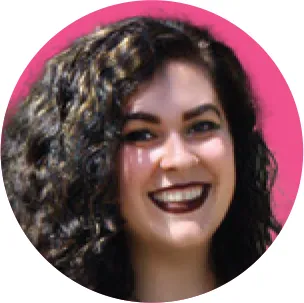
MADELEINE MOORE ’15
FORMER PRESIDENT OF THE PRIDE ALLIANCE AND VICE PRESIDENT OF OUT IN SCIENCE, TECH, ENGINEERING AND MATH
You can’t be a queer student leader on campus and not be involved with the Equity Center. I was part of the inaugural class of the Lavender Leadership Honor Society. It felt really empowering to be recognized not just as a queer student who was in college, but someone whose queerness positively impacted the college.
At the induction ceremony, students were asked to align themselves with one of the eight original colors of the Pride flag and what it meant to them and their time at UMD. It was so celebratory and queer and probably the most impactful Equity Center experience for me.
SAKURAI: When we created the honor society, we considered including GPA as a component, but for us, it was more about alignment with a set of values: inclusion, kindness and authenticity. We looked for folks who had put those values into action on and off campus. All kinds of people came out of the woodwork that we had no idea even existed.
That was one of the ways we built capacity, so others could lead and work on their own in different segments of the institution. With just three full-time staff, how do you impact 50,000 people? We didn’t want people to just rely on this one center to do all the things. We wanted them to see us as a usefulpartner and supporter and convener, but remind people that everyone has a role being engaged as LGBTQ+ advocates and allies.

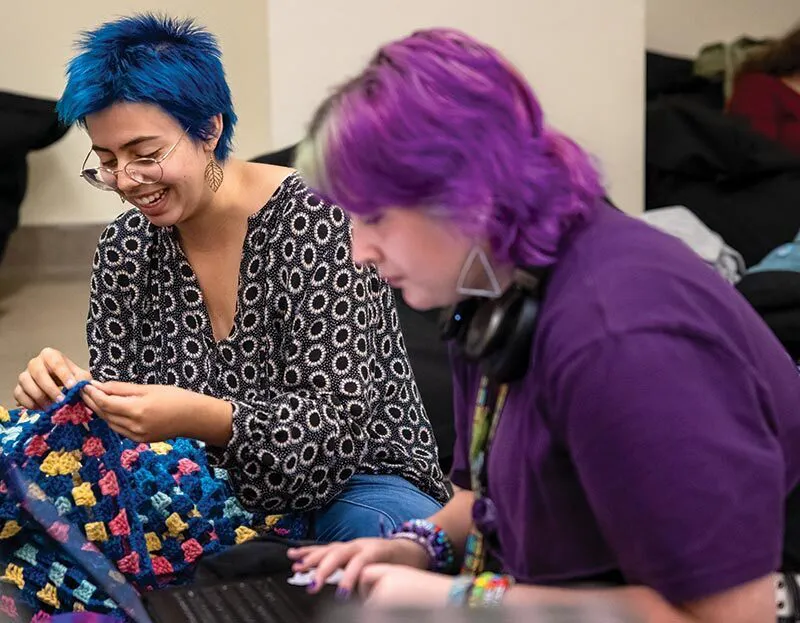
Today, UMD community members can change their primary name on university ID cards, class rosters and directories; find gender-neutral bathrooms in most buildings; access LGBTQ+-specific Counseling Center services; live in queer-friendly campus housing; and are protected by a nondiscrimination policy. Queer affinity groups abound, including ones for Jewish, Black and disabled students, and the LGBTQ+ Equity Center hosts events such as Queer Recess, featuring Pride chalking, collaging and video and board games.
JENSEN: Lavender Graduation wraps up our year, celebrating the students who persevered. We held our first one in 1999. What’s unique is every graduate gets a chance to talk. It gets me choked up even now. A lot of these students didn’t have particularly good relationships with their parents, so they thank the parents who are there.
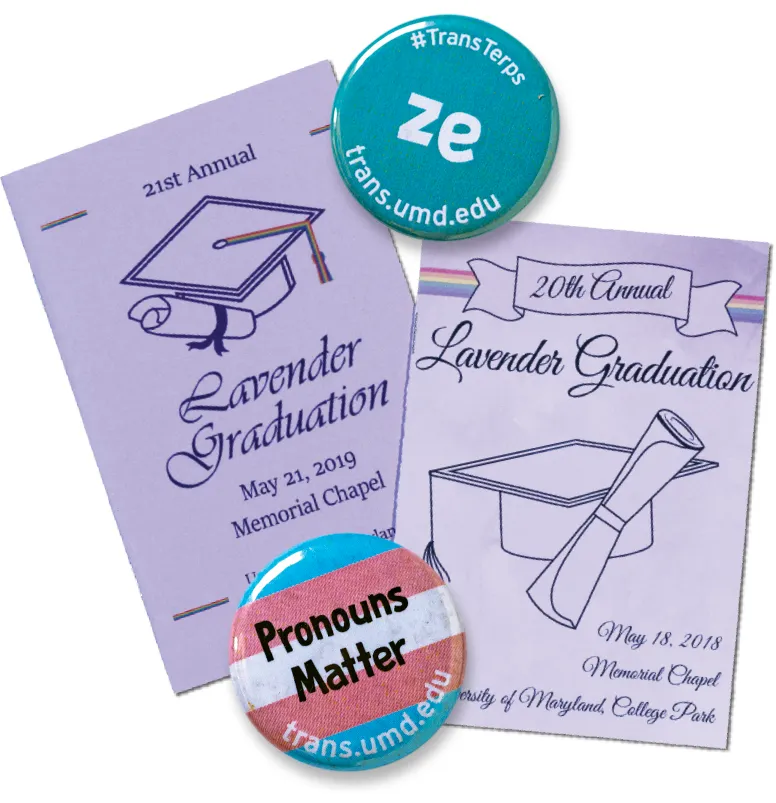
FRIES: Coming back as a graduate student, almost a decade later, I was so pleased I could walk at graduation (in 2005) with the rainbow tassel.
SAKURAI: Looking forward, I would like to see more structural responses—policies, best practices, staffing and resources—to intersectionality. Throughout my time at the equity center, the majority of people who interacted with it were in the BIPOC (Black, Indigenous, People of Color) community, and a large percentage were also trans and nonbinary. That’s often because folks who are not in more heavily marginalized identities don’t
feel the need to come to an identity-based program and can go to more mainstream spaces.
JENSEN: I’d also like to see more support and advocacy for employees, as well as more consistent gatherings and programming for Lambda Pride, the alum group.
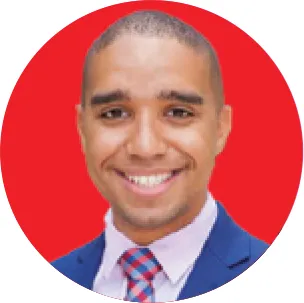
KRISTOPHER OLIVEIRA
DIRECTOR OF THE LGBTQ+ EQUITY CENTER
Since I arrived over the summer, I’ve felt the love for this center and its history. Coming out of the pandemic, community-building is so important. We’re collaborating with MICA (Multicultural Involvement Community Advocacy), the Pride Alliance and other campus organizations host programs, and to understand what our students, faculty and staff need.
I also want to interrogate our approach to the Campus Pride Index, where we’ve been named the No. 1 college for LGBTQ+ students. That’s great. But rather than saying, yes, we have gender-inclusive housing on campus, I want to work with Student Affairs colleagues to enhance housing options for our students. There’s always work to do.
This story is featured in the Winter 2024 issue of Terp magazine. Find all the stories online at terp.umd.edu.
Topics
Campus & Community